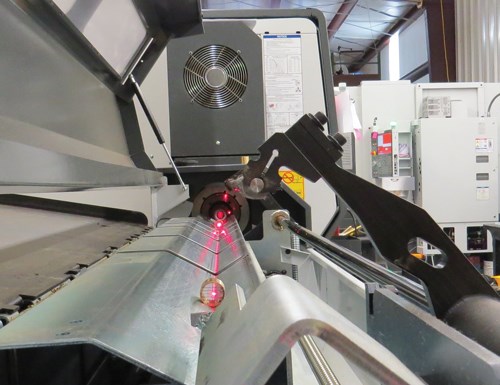Laser Device Helps to Align Bar Feeders
One of the most common issues affecting bar feeder performance is wear and tear on the bar feeder liner or collet caused by inaccurate alignment between the bar feeder and the lathe.
Extending equipment life and minimizing maintenance are significant factors in process improvement and can have a direct effect on high profits. Successful shops keep an eye out for products and processes that contribute to keeping their machines running.
One of the most common issues affecting bar feeder performance is wear and tear on the bar feeder liner or collet caused by inaccurate alignment between the bar feeder and the lathe. Typically caused by vibration during production or accidental bumping of the bar feeder, misaligned bar feeders lead to more frequent production stops and time consuming bar feeder maintenance.
Featured Content
Regularly scheduled alignment and careful attention to incidents that may influence the current alignment can help to minimize more significant downtime. But conventional alignment methods, such as the use of tight wire or line, or even simply eyeballing the setup, can often be time consuming and inaccurate. High-end laser alignment systems can be costly and typically require a significant amount of training.
Affordable Solution
The L56SS bar feeder alignment system from Laser Tools Company Inc. was designed as an affordable, simple system to enable shops to quickly and accurately check bar feeder alignment. The system uses a straight beam of laser light and two targets to center and position the bar feeder carriage to the right height for supplying barstock material to the lathe spindle. The alignment of the center of the bar to the center of the spindle is critical because the barstock is automatically pushed or fed into the lathe’s spindle in order to begin the machining process. Proper alignment reduces wear on spindle liners and guide bushings, ensures correct remnant release, assists in end of bar management, and saves valuable setup time.
Each bar feeder alignment system includes the AP15 Aperture Pack with 1/16 inch, 3/32 inch and 1/8 inch apertures. The apertures are used to resize the laser beam for best overall viewing preference. The small, 1/16 inch aperture is used for short distances of less than 15 feet. The large apertures are for distances as long as 30 feet. The laser can be used without an aperture for longer distances.
A recent change in the system design allows the magnetic spindle adapter to accommodate bores as small as 0.0393 inch (1 mm) for efficient operation with Swiss-type machines. On Swiss machines, the AP56 magnetics spindle adapter and laser assembly should be mounted onto the headstock over the spindle collet. One target should be placed at the entry point of the bar feeder and the other at the furthest point on the bar feeder.
How it Works
To align the bar feeder, the L56 industrial alignment laser is chucked within the lathe’s spindle so that the laser beam shoots through the spindle and down the carriage of the bar feeder. Two targets are used to register the vertical and horizontal positions of the front and back portion of the bar feeder’s carriage. The left and right of center is adjusted during the installation of the bar feeder, but is often readjusted when the feeder is moved or bumped. Depending upon the style of bar feeder, the height is adjusted manually each time a new diameter of barstock is loaded into the bar feeder.
The laser beam is concentric to the case of the laser and will automatically center within the spindle when the chuck or collet is closed. A transparent target with graduations is placed onto the carriage and close to the spindle opening. A second translucent target is placed onto the carriage at the furthest point. The laser is designed to shoot through the first transparent target and onto the second red translucent target. The laser beam goes through the second target in order to focus on the exit side of the target. This is where the height graduations are located.
The alignment system is designed as a preventive maintenance tool and to assist in decreasing setup time. It can reduce maintenance costs, emergency repairs, energy consumption, vibration and unplanned downtime to contribute to optimized production.
RELATED CONTENT
-
What Is The Best Bar Feed System For Production Turning?
Selecting the right bar feeder can be one of the most important decisions a shop can make. Bar feed systems help improve productivity, throughput and quality, but in order to achieve the most benefit from them it is essential that a bar feed system be matched to the particular needs of the turning operation.
-
Simplifying Machine Load/Unload Automation
Today, lower part volumes and frequent change-over are changing the offerings of some automation integrators. Standard, off-the-shelf components are being engineered to work together in a large variety of applications and, in some cases, are even portable so they can be moved from machine tool to machine tool.
-
Checklist for Lights-Out Manufacturing
Many shops of various sizes are trying to hop on the lights-out bandwagon. This article looks at some things to consider and check out before “hopping.”









